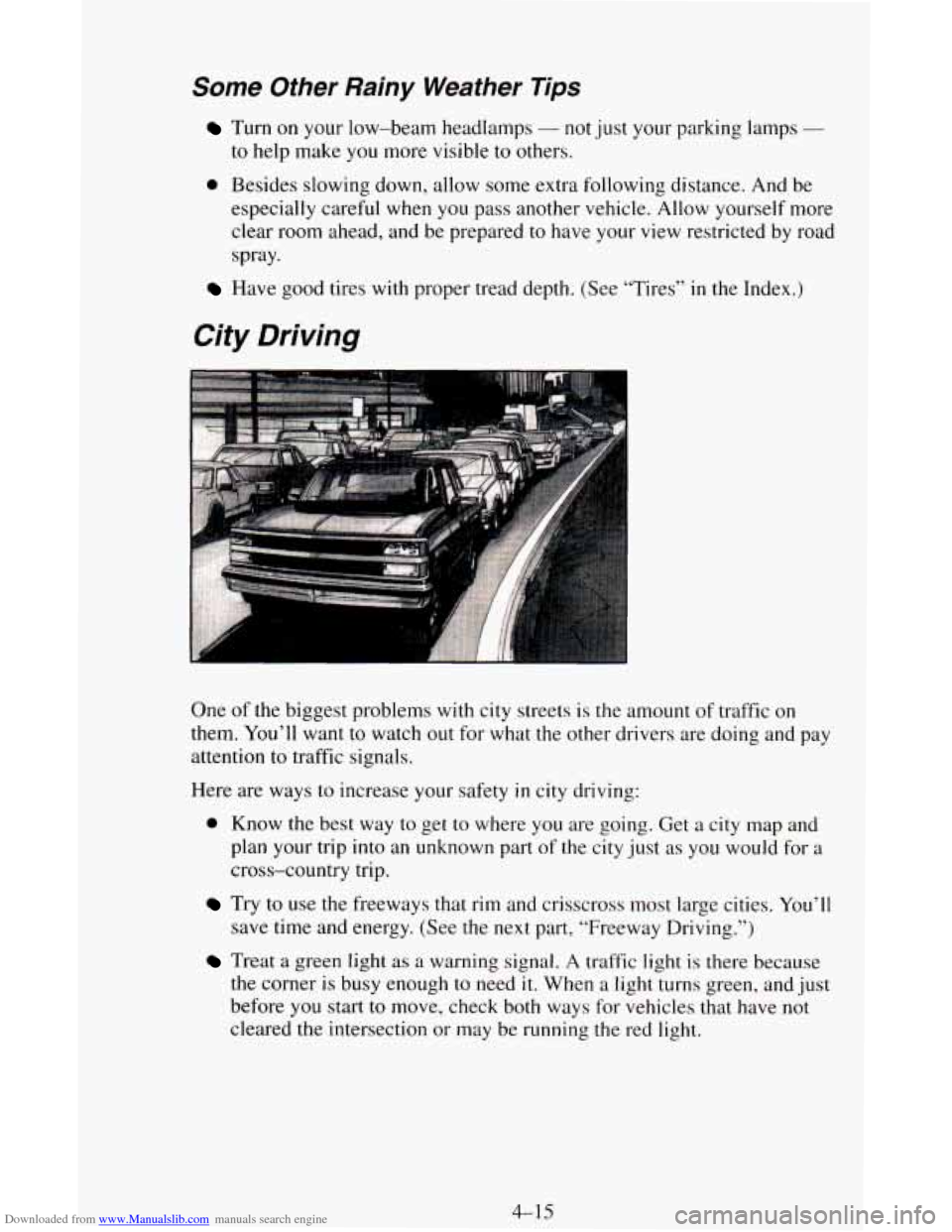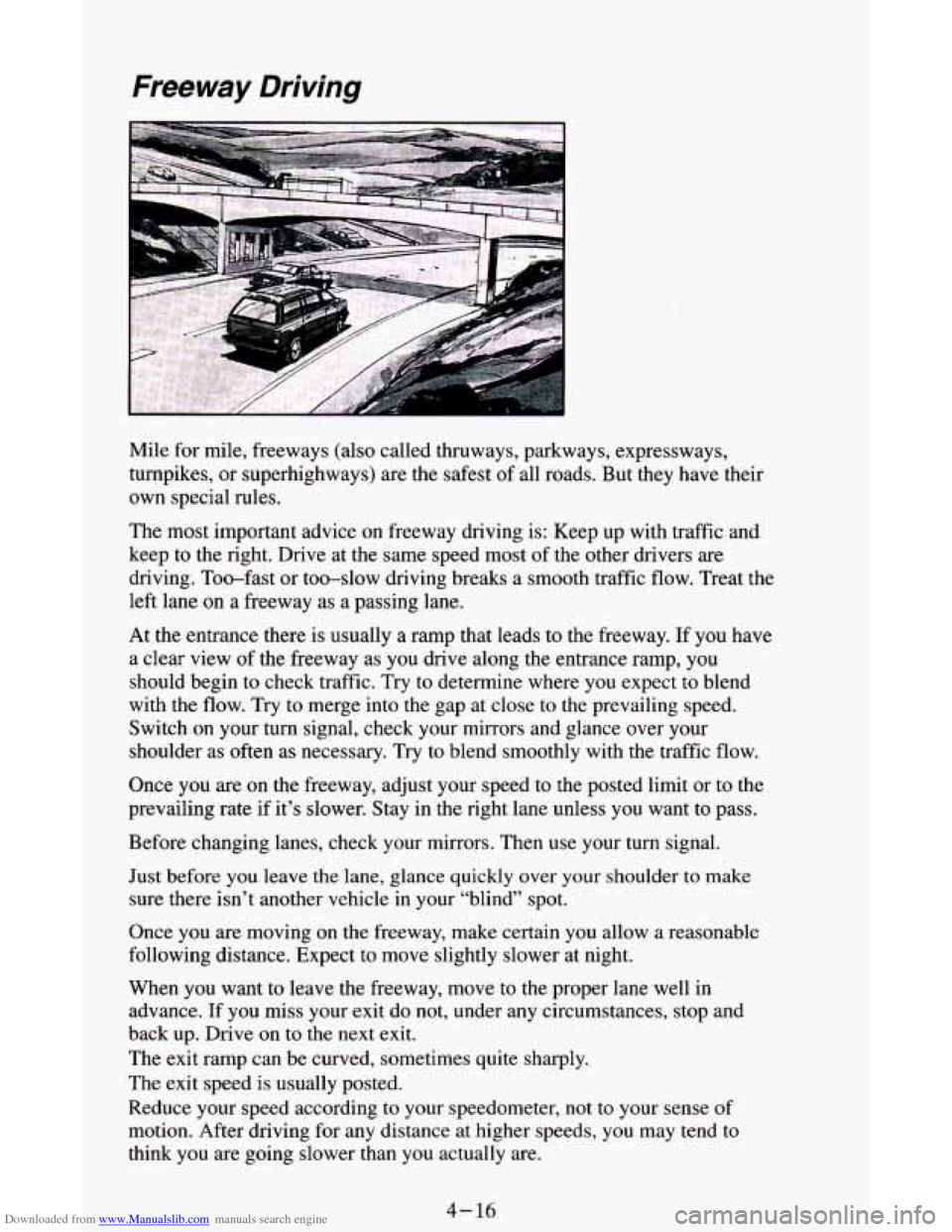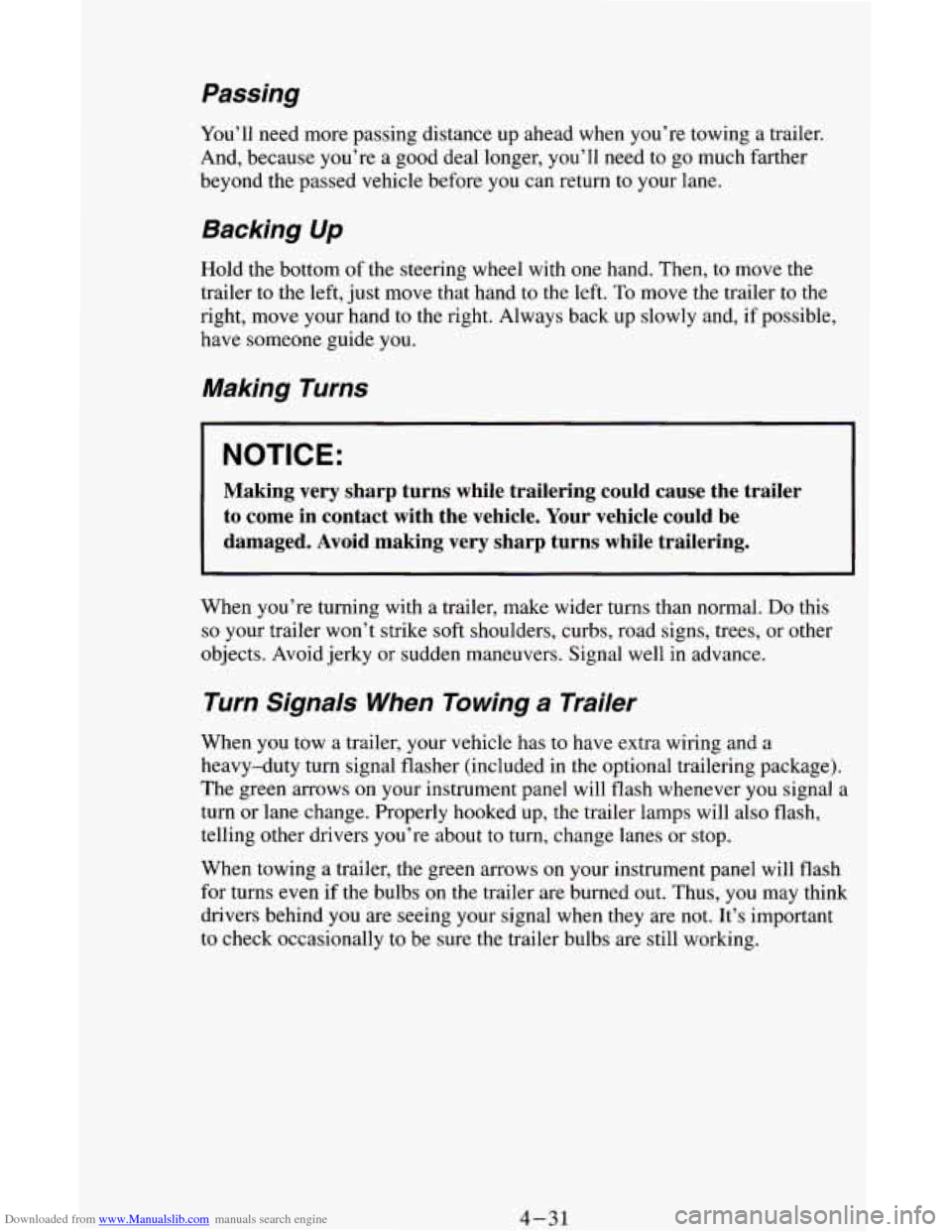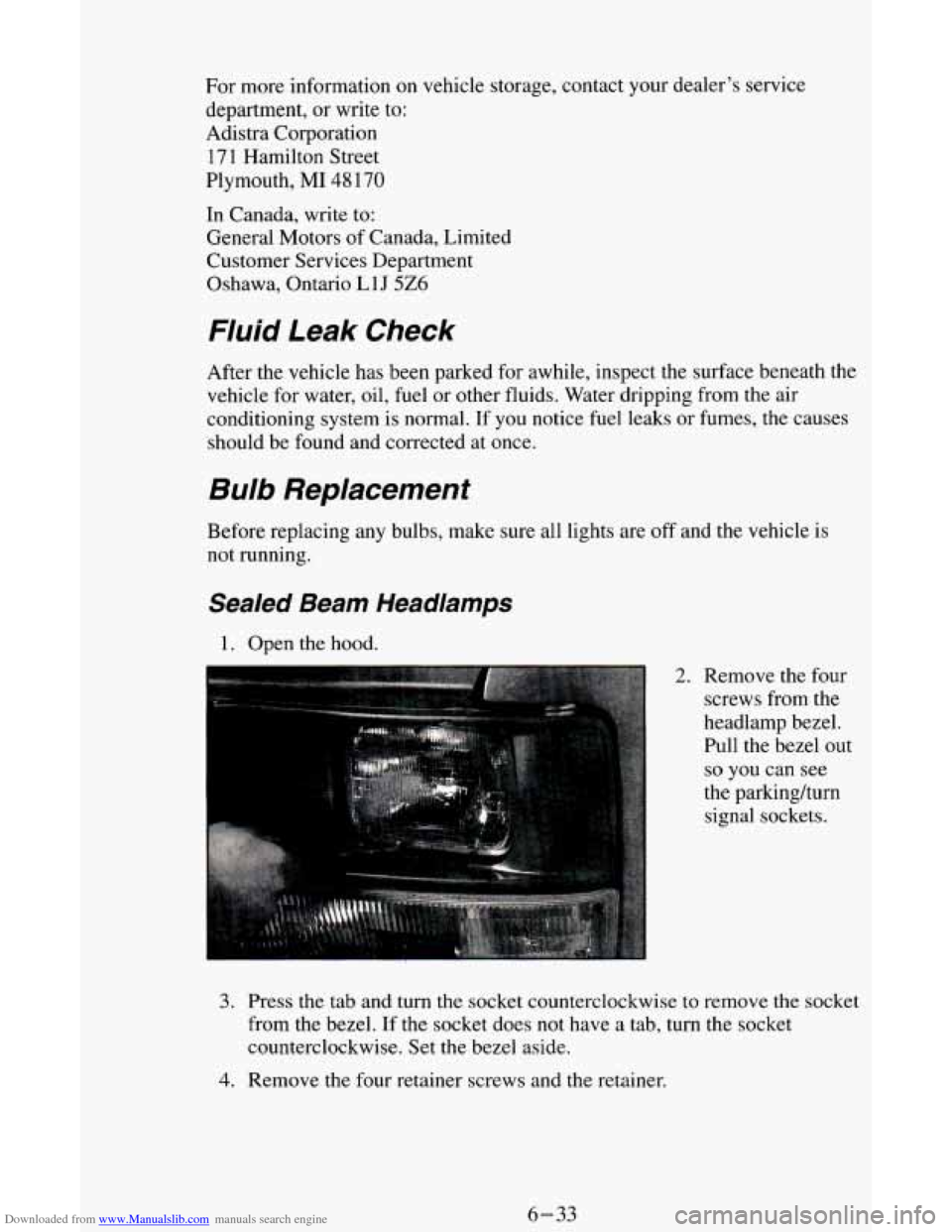Page 153 of 342

Downloaded from www.Manualslib.com manuals search engine Some Other Rainy Weather Tips
Turn on your low-beam headlamps - not just your parking lamps -
0 Besides slowing down, allow some extra following distance. And be
to help make you more visible to others.
especially careful when you pass another vehicle. Allow yourself more
clear room ahead, and be prepared to have your view restricted by road
spray.
Have good tires with proper tread depth. (See “Tires” in the Index.)
City Driving
a
One of the biggest problems with city streets is the amount of traffic on
them. You’ll want to watch out for what the other drivers are doing and pay
attention
to traffic signals.
Here are ways to increase your safety
in city driving:
0 Know the best way to get to where you are going. Get a city map and
plan your trip into an unknown part
of the city just as you would for a
cross-country trip.
save time and energy. (See the next part, “Freeway Driving.”)
Treat a green light as a warning signal. A traffic light is there because
the corner is busy enough to need
it. When a light turns green, and just
before
you start to move, check both ways for vehicles that have not
cleared the intersection or may be running
the red light.
Try to use the freeways that rim and crisscross most large cities. You’ll
4-15
Page 154 of 342

Downloaded from www.Manualslib.com manuals search engine Freeway Driving
Mile for mile, freeways (also called thruways, parkways, expressways,
turnpikes, or superhighways) are the safest of all roads. But they have their
own special rules.
The most important advice on freeway driving is: Keep up with traffic and
keep to the right. Drive at the same speed most of the other drivers are
driving. Too-fast or too-slow driving breaks a smooth traffic flow. Treat the
left
lane on a freeway as a passing lane.
At
the entrance there is usually a ramp that leads to the freeway. If you have
a clear view of the freeway as you drive along the entrance ramp, you
should begin to check traffic. Try to determine where you expect to blend
with the flow. Try to merge into the gap at close to the prevailing speed.
Switch on your turn signal, check your mirrors and glance over your
shoulder as often as necessary. Try to blend smoothly with the traffic flow.
Once you are
on the freeway, adjust your speed to the posted limit or to the
prevailing rate if it’s slower. Stay in the right lane unless you want to pass.
Before changing lanes, check your mirrors. Then use your turn signal.
Just before you leave the lane, glance quickly over your shoulder
to make
sure there isn’t another vehicle in your “blind” spot.
Once you are moving on the freeway, make certain you allow
a reasonable
following distance. Expect to move slightly slower at night.
When
you want to leave the freeway, move to the proper lane well in
advance.
If you miss your exit do not, under any circumstances, stop and
back up. Drive on to the next exit.
The exit ramp can be curved, sometimes quite sharply.
The exit speed is usually posted.
Reduce your speed according to your speedometer, not to your sense of
motion. After driving for any distance at higher speeds, you may tend to
think you are going slower than you actually are.
4- 16
Page 169 of 342

Downloaded from www.Manualslib.com manuals search engine Passing
You’ll need more passing distance up ahead when you’re towing a trailer.
And, because you’re a good deal longer, you’ll need to go much farther
beyond the passed vehicle before
you can return to your lane.
Backing Up
Hold the bottom of the steering wheel with one hand. Then, to move the
trailer to the left,
just move that hand to the left. To move the trailer to the
right, move your hand to the right. Always back up slowly and, if possible,
have someone guide you.
Making Turns
NOTICE:
Making very sharp turns while trailering could cause the traile\
r
to come in contact with the vehicle. Your vehicle could be
damaged. Avoid making very sharp turns while trailering.
When you’re turning with a trailer, make wider turns than normal. Do this
so your trailer won’t strike soft shoulders, curbs, road signs, trees, or other
objects. Avoid jerky or sudden maneuvers. Signal well in advance.
Turn Signals When Towing a Trailer
When you tow a trailer, your vehicle has to have extra wiring and a
heavy-duty turn signal flasher (included in the optional trailering package).
The green arrows
on your instrument panel will flash whenever you signal a
turn or lane change. Properly hooked up, the trailer lamps will also flash,
telling other drivers you’re about
to turn, change lanes or stop.
When towing a trailer, the green arrows
on your instrument panel will flash
for turns even if the bulbs
on the trailer are burned out. Thus, you may think
drivers behind you are seeing your signal when they are not. It’s important
to check occasionally to be sure the trailer bulbs are still working.
4-31
Page 173 of 342
Downloaded from www.Manualslib.com manuals search engine Problems on the Road
Here you’ll find what to do about some problems that can occur on the road.
Hazard Warning Flashers
Your hazard warning flashers let you warn others. They also let police know
you have a problem. Your front and rear turn signal lamps will flash on and
off.
5-1
Page 174 of 342
Downloaded from www.Manualslib.com manuals search engine But they won’t flash if you’re braking. Press the button
in to
make your front and
rear turn signal lights
flash
on and off. Your
hazard warning
flashers work no
matter what position
your key
is in, and
even
if the key isn’t
in.
To turn off the
flashers, pull out on
the collar.
When the hazard warning flashers are on, your turn signals
won’t work.
Other Warning Devices
If you carry reflective triangles, you can set one up at the side of the road
about
300 feet (100 m) behind your vehicle.
5-2
Page 241 of 342

Downloaded from www.Manualslib.com manuals search engine For more information on vehicle storage, contact your dealer’s service
department, or write to:
Adistra Corporation
17 1 Hamilton Street
Plymouth, MI
48 170
In Canada, write to:
General Motors of Canada, Limited
Customer Services Department
Oshawa, Ontario
Ll J 5Z6
Fluid Leak Check
After the vehicle has been parked for awhile, inspect the surface beneath the
vehicle for water, oil,
fuel or other fluids. Water dripping from the air
conditioning system is normal. If you notice fuel leaks or fumes, the causes
should be found and corrected at once.
Bulb Replacement
Before replacing any bulbs, make sure all lights are off and the vehicle is
not running.
Sealed Beam Headlamps
1. Open the hood.
2. Remove the four
screws from the
headlamp bezel.
Pull the bezel out
so you can see
the parkingkurn
signal sockets.
3. Press the tab and turn the socket counterclockwise to remove the socket
from the bezel. If the socket does
not have a tab, turn the socket
counterclockwise. Set the bezel aside.
4. Remove the four retainer screws and the retainer.
6-33
Page 243 of 342
Downloaded from www.Manualslib.com manuals search engine Composite Headlamps
1. Open the hood.
2. Remove the two screws from the
side markedturn
signal lamp.
3. Completely
remove the sidemarker/turn
signal lamp by
pulling out the
assembly and
disconnecting the
side markedturn
signal lamp sockets from the
lamp.
I
4. Remove the
screw located
behind the corner
reflector in order to remove the entire corner
reflector.
6-35
Page 245 of 342
Downloaded from www.Manualslib.com manuals search engine Front Parlcrrurn Signal Lamps (Composite and Sealed Beam)
1. Remove the two screws at the inside edge of the parking/turn signal
lamp assembly.
2. Remove +he lamp awmbly.
3. Squeeze the tab
on the side
of the
lamp socket while
turning the socket
counterclockwise.
4. Pull the socket out of the lamp assembly.
5. Pull the bulb from the socket.
6. Gently push the new bulb into the socket.
7. ht the socket back into the lamp assembly and turn it clockwise until it
locks.
8. Put the parking/turn signal lamp assembly back into the vehicle and
tighten the screws.
6-37